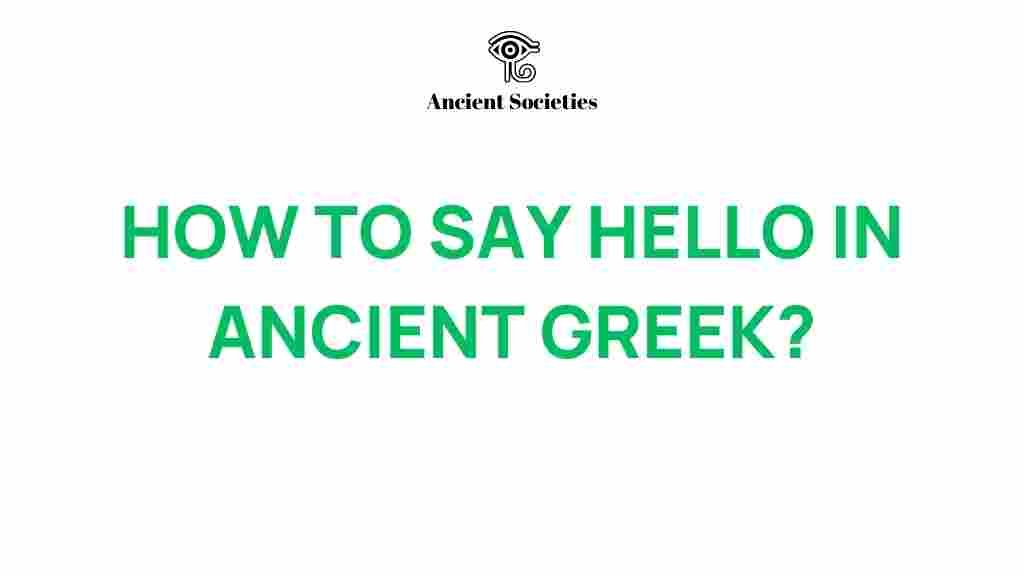Discovering the Art of Greeting: How to Say Hello in Ancient Greek
Greetings are fundamental to human communication, serving as a bridge between individuals and cultures. In the realm of Ancient Greek language and culture, the way people greeted one another reflected their social norms, values, and relationships. Understanding how to say hello in Ancient Greek not only enhances our appreciation for this rich linguistic tradition but also provides insight into the broader context of Hellenistic civilization.
The Importance of Greetings in Ancient Greek Culture
Greetings in Ancient Greek society were more than mere words; they were a vital part of social interaction that conveyed respect, familiarity, and status. The language of greetings can reveal much about the culture and history of the time. Here are some key points to consider:
- Social Hierarchy: Greetings often reflected the social standing of individuals. A simple greeting could vary significantly based on who was speaking and their relationship.
- Contextual Nuance: Different situations called for different forms of greetings, from formal encounters to casual meetings among friends.
- Language as Connection: The use of Ancient Greek for greetings was a way to connect with others and affirm one’s identity within the culture.
Common Greetings in Ancient Greek
In Ancient Greek, the primary way to say hello was through various forms depending on the time of day and the formality of the interaction. Here are some common greetings:
- Χαίρε (Chaire): This is perhaps the most common greeting, meaning “rejoice” or “be glad.” It was often used in both formal and informal settings.
- Ἐρρωσθε (Errōsithe): A more formal greeting, translating to “be strong.” It was often used to express goodwill.
- Καλημέρα (Kalēmera): Meaning “good day,” this greeting was used during the daytime.
- Καλησπέρα (Kalēspera): This means “good evening,” suitable for later interactions.
- Ἀσπασμός (Aspasmós): This term refers to a salutation and was often used in formal contexts.
A Step-by-Step Guide to Using Ancient Greek Greetings
Learning how to greet someone in Ancient Greek can be a delightful experience. Here’s a simple guide to help you incorporate these greetings into your interactions:
- Understand the Context: Before greeting someone, consider the time of day and the nature of your relationship.
- Choose the Right Greeting: Select an appropriate greeting from the list above based on the context.
- Practice Pronunciation: Pronounce the greeting clearly. For example, “Χαίρε” is pronounced as “KHAIR-ay.”
- Use Non-verbal Cues: Accompany your greeting with a smile or nod to enhance the warmth of your communication.
- Engage in Follow-Up: After greeting, engage the person in conversation to foster connection.
Exploring the Linguistics of Ancient Greek Greetings
The study of how greetings function in Ancient Greek involves understanding the linguistic structures and cultural implications. Here are some points of interest in the linguistics of these greetings:
- Syntax and Grammar: Ancient Greek has a rich grammatical structure that influences how greetings are formed.
- Phonetics: The sounds of the language convey emotion and intent, making the pronunciation of greetings significant.
- Semantic Nuance: Different greetings carry different weights and connotations, reflecting the speaker’s intent.
Troubleshooting Common Mistakes in Ancient Greek Greetings
When using Ancient Greek greetings, you might encounter some challenges. Here are troubleshooting tips to ensure effective communication:
- Incorrect Pronunciation: If unsure about pronunciation, listen to audio resources or consult with a linguist.
- Context Misunderstanding: If you feel your greeting was inappropriate, observe the responses of others and adjust accordingly in the future.
- Overly Formal or Casual: Gauge the relationship and setting to avoid being too formal or too casual.
Conclusion: Embracing the Greetings of Ancient Greek Culture
Understanding how to greet someone in Ancient Greek opens a window into the rich tapestry of Hellenistic culture and communication. By mastering these greetings, you not only learn a valuable linguistic skill but also gain insights into the social fabric of ancient societies.
As you practice these greetings, remember that communication is not just about words; it’s about connection. Embrace the art of greeting as a way to honor the history and culture of the Ancient Greek civilization.
For further exploration of Ancient Greek language and culture, check out this resource. Additionally, you can learn more about the broader impacts of language on communication and culture by visiting this site.
This article is in the category Culture and created by AncientSocieties Team

1 thought on “Discovering the Art of Greeting: How to Say Hello in Ancient Greek”